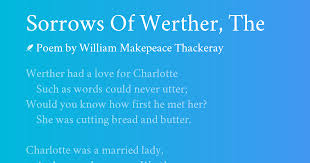Thackeray is widely regarded as one of the greatest poets of the twentieth century, known for his poems that often carry several layers of meaning. One of his well-known poems, “Sorrows of Werther,” stands out as a masterpiece of satire, filled with biting irony and commentary.
Summary and Analysis
The poem “Sorrows of Werther” tells the tale of a married woman, whom we encounter at the beginning of the poem, busy cutting bread and butter. Werther, a man who becomes infatuated with Charlotte, meets her while she is engaged in her domestic chores, perhaps while working in her own house. The poet, Thackeray, may have witnessed this encounter, providing him with the inspiration for the poem.
“Would you know how first he met her? She was cutting bread and butter.”
These lines emphasize their initial meeting, but as Charlotte is married, Werther’s love remains unrequited. The second stanza highlights that he is aware of her marital status, and being a moral man, he refrains from pursuing his feelings further. He struggles internally with his passion for her, which remains hidden and unexpressed, making it akin to a simmering pot that boils and bubbles but does not overflow.
“Charlotte, having seen his body Borne before her on a shutter,”
As the poem progresses, Charlotte becomes aware of Werther’s presence, possibly due to his death, as implied by “borne before her on a shutter.” However, she does not know much about him or his feelings.
 Sorrows of Werther by ThackerayThe poem masterfully explores themes of love and societal constraints. Thackeray’s mockery is evident in how society forbids a man from openly expressing his love for a married woman. The title “Sorrows of Werther” reflects the internal struggle and sorrow Werther experiences due to his unfulfilled passion. Despite only meeting Charlotte once, his emotional turmoil is significant, indicating the intensity of his emotions and the societal limitations placed on love.
Sorrows of Werther by ThackerayThe poem masterfully explores themes of love and societal constraints. Thackeray’s mockery is evident in how society forbids a man from openly expressing his love for a married woman. The title “Sorrows of Werther” reflects the internal struggle and sorrow Werther experiences due to his unfulfilled passion. Despite only meeting Charlotte once, his emotional turmoil is significant, indicating the intensity of his emotions and the societal limitations placed on love.
Themes

While love is the primary theme of the poem, Thackeray weaves in other minor themes as well. One such theme is “mockery,” where the poet ridicules the societal norms that restrict expressions of love between individuals due to their marital status.
Painting of Young Werther:
The mention of “Painting of Young Werther” refers to Johann Wolfgang von Goethe’s novel, “The Sorrows of Young Werther,” which revolves around a similar theme of unrequited love and its consequences. Thackeray may be drawing a parallel to Goethe’s work to further emphasize the universality of such emotional struggles.
Literary Devices
Thackeray employs various rhetorical devices that enrich the poem’s quality. The poem is structured into four quatrains, each with four lines, and is written in blank verse, providing it with a structured yet lyrical flow.
Enjambment, the continuation of a sentence across multiple lines, is used skillfully in lines like:
“And a moral man was Werther, And, for all the wealth of Indies, Would do nothing for to hurt her.”
Alliteration, the repetition of consonant sounds, adds musicality and emphasis to phrases like “bread and butter” and “boiled and bubbled.”
Symbolism is evident when Thackeray describes Werther’s passion as “boiled and bubbled,” representing the turmoil within him.
In conclusion, “Sorrows of Werther” is a brilliantly crafted poem by Thackeray, using various literary devices to capture the complexities of unexpressed love and societal constraints. Through subtle satire and symbolism, the poem conveys powerful emotions and resonates with readers as a timeless exploration of human relationships and the social norms that govern them.
